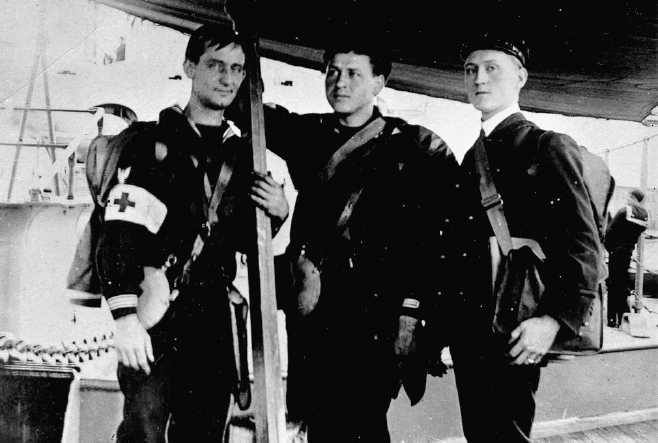HOSPITAL APPRENTICES AND
PHARMACIST’S MATES
The next revision in the structure of the Hospital
Corps came by act of Congress on August 29, 1916.
Under this plan, the rates were hospital apprentices,
second class and first class (both of whom wore a red
cross on the sleeve); pharmacist’s mates, third, second,
and first; and chief pharmacist’s mate. The officer
contingent of the Hospital Corps included the two
warrant officer ranks of
pharmacist and chief
pharmacist. The reorganization allowed for a massive,
fivefold increase in the size of the Hospital Corps.
At the start of 1917, the Hospital Corps counted
1,700 men in its ranks. A concerted effort to recruit and
train new personnel enabled the corps to reach its
authorized strength of 3 1/2 percent of the Navy and
Marine Corps, or 6,000 men. But as these plans came
to fruition, the United States entered World War I in
April. By the end of 1918, the corps peaked at about
17,000.
PHARMACIST’S MATES IN WORLD WAR I
The massive wartime expansion in Hospital Corps
strength necessitated additional schools to train the
newcomers. Hospital Corps School, Great Lakes,
Illinois, had been established in January 1913.
Wartime schools were created in Minneapolis at the
University of Minnesota, in New York at Columbia
University, and at the Philadelphia College of
Pharmacy. A school for Naval Reserve Force Hospital
Corpsmen was set up at Boston City Hospital. Other
crash-course schools for shipboard personnel were
conducted at a number of other civilian hospitals.
Hospital Corpsmen who were needed to serve as
medical department representatives on small vessels
such as destroyers were trained at the Pharmacist’s
Mate School at Hampton Roads, Virginia, the
AI-4
HM3FAI02
Figure APP-I-2.—A hospital steward (chief petty officer) and two hospital apprentices from a ship’s landing party medical section,
1905.

